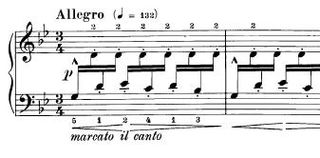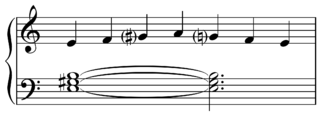Related Research Articles

Flamenco, in its strictest sense, is an art form based on the various folkloric music traditions of southern Spain, originating in the region of Andalusia, but also having a historical presence in Extremadura and Murcia. In a wider sense, the term is used to refer to a variety of Spanish musical styles. The oldest record of flamenco music dates to 1774 in the book Las Cartas Marruecas by José Cadalso. Although Flamenco is often associated to the Gitano ethnicity who have contributed significantly to its development, its origin and style are uniquely Andalusian and Flamenco artists have historically included Spaniards of both gitano and non-gitano heritage.
In music theory, the term minor scale refers to three scale patterns – the natural minor scale, the harmonic minor scale, and the melodic minor scale – rather than just one as with the major scale.
The Phrygian mode can refer to three different musical modes: the ancient Greek tonos or harmonia sometimes called Phrygian, formed on a particular set of octave species or scales; the Medieval Phrygian mode, and the modern conception of the Phrygian mode as a diatonic scale, based on the latter.
In flamenco a tango is one of the flamenco palos closely related in form and feeling to the rumba flamenca. It is often performed as a finale to a flamenco tiento. Its compás and llamada are the same as that of the farruca and share the farruca's lively nature. However, the tango is normally performed in the A Phrygian mode. In some English sources the flamenco tango is written with an -s; "the tangos is..."
In music, the Phrygian dominant scale is the fifth mode of the harmonic minor scale, the fifth being the dominant. Also called the altered Phrygian scale, dominant flat 2 flat 6 (in jazz), the Freygish scale (also spelled Fraigish), harmonic dominant, or simply the fifth mode of the harmonic minor scale. It resembles the scale of the Phrygian mode but has a major third. In the Berklee method, it is known as the Mixolydian ♭9 ♭13 chord scale, a Mixolydian scale with a lowered 9th (2nd) and lowered 13th (6th), used in secondary dominant chord scales for V7/III and V7/VI.
A heptatonic scale is a musical scale that has seven pitches per octave. Examples include the major scale or minor scale; e.g., in C major: C D E F G A B C—and in the relative minor, A minor, natural minor: A B C D E F G A; the melodic minor scale, A B C D E F♯G♯A ascending, A G F E D C B A descending; the harmonic minor scale, A B C D E F G♯A; and a scale variously known as the Byzantine, and Hungarian, scale, C D E♭ F♯ G A♭ B C. Indian classical theory postulates seventy-two seven-tone scale types, collectively called thaat, whereas others postulate twelve or ten seven-tone scale types.

Asturias (Leyenda), named simply Leyenda by its composer, is a musical work by the Spanish composer and pianist Isaac Albéniz (1860-1909).

The Andalusian cadence is a term adopted from flamenco music for a chord progression comprising four chords descending stepwise—a iv-III-II-I progression with respect to the Phrygian mode or i–VII–VI–V progression with respect to the minor mode. It is otherwise known as the minor descending tetrachord. Traceable back to the Renaissance, its effective sonorities made it one of the most popular progressions in classical music Play (help·info).
In music, the double harmonic major scale is a scale whose gaps may sound unfamiliar to Western listeners. This is also known as Mayamalavagowla, Bhairav Raga, Byzantine scale, Arabic, and Gypsy major. It can be likened to a gypsy scale because of the diminished step between the 1st and 2nd degrees. Arabic scale may also refer to any Arabic mode, the simplest of which, however, to Westerners, resembles the double harmonic major scale.
The Hungarian minor scale, double harmonic minor scale, or Gypsy minor scale is a type of combined musical scale. It is the fourth mode of the double harmonic scale. It is the same as the harmonic minor scale, except that it has a raised fourth scale degree to introduce an additional gap, or augmented second. It is a symmetrical scale with a slightly ambiguous tonal centre, due to the many half steps.
Malagueñas is one of the traditional styles of Andalusian music (flamenco), derived from earlier types of fandango from the area of Málaga, classified among the Cantes de Levante. Originally a folk-song type, it became a flamenco style in the 19th century. It is not normally used for dance, as it is generally interpreted with no regular rhythmic pattern, as a "cante libre". It has a very rich melody with virtuous flourishes and use of microtones. Its guitar accompaniment is normally played in open position first inversion giving E for the tonic, which can be transposed by using a capo.
Polo is the name of a flamenco palo or musical form. There is only one known song in this palo, which is extremely similar to another palo called caña, and its guitar accompaniment, like the caña, shares its rhythm and motifs with soleá. Both the caña and polo share the same musical mode. The polo has usually been considered as a derivation of the caña. To complete the singing of the polo, singers usually sing a stanza in the palo of soleá, generally in the style called soleá apolá.
The Persian scale is a musical scale occasionally found in guitar scale books, along other scales inspired by Middle Eastern music. It is characterized by the liberal use of half steps (4), augmented seconds (2), and frequent use of chromaticism. Compare this to the one augmented second of the harmonic minor or the use of only two half-steps in all diatonic scales. This is also the Locrian mode with a major third and major seventh degree.

Soleares is one of the most basic forms or palos of Flamenco music, probably originated around Cádiz or Seville in Andalusia, the most southern region of Spain. It is usually accompanied by one guitar only, in phrygian mode "por arriba" ; "Bulerías por soleá" is usually played "por medio". Soleares is sometimes called "mother of palos" although it is not the oldest one and not even related to every other palo

Chants d'Espagne, Op. 232, is a suite of originally three, later five pieces for the piano by Isaac Albéniz. Prélude, Orientale and Sous le palmier were published in 1892, and Córdoba and Seguidillas were added in the 1898 edition. According to Günter Schulze, "Many...[of the works] have the flavor of the flamenco so beloved of Albéniz."[1]

In music theory, the flamenco mode is a harmonized mode or scale abstracted from its use in flamenco music. In other words the collection of pitches in ascending order accompanied by chords represents the pitches and chords used together in flamenco songs and pieces. The key signature is the same as that of the Phrygian mode, with the raised third and seventh being written in as necessary with accidentals. Its modal/tonal characteristics are prominent in the Andalusian cadence.
In music, the major Neapolitan scale and the minor Neapolitan scale are two musical scales. Both scales are minor, despite their names.
In music, the Romanian Minor scale or Ukrainian Dorian scale or altered Dorian scale is a musical scale or the fourth mode of the harmonic minor scale. It is "similar to the dorian mode, but with a tritone and variable sixth and seventh degrees". It is related to both the Freygish and Misheberak scales and is used in Jewish music, "predominant in klezmer bulgarish and doina (doyne)." "When the Ukrainian Dorian scale functions in the synagogue, it is a mode known as the Mi sheberach or Av horachamim. Arab and Greek scholars give other names to the scale: Nikriz (نكريز) and Aulos, respectively."
"Nardis" is a composition by American jazz musician Miles Davis. It was written in 1958, during Davis's modal period, to be played by Cannonball Adderley for the album Portrait of Cannonball. The piece has come to be associated with pianist Bill Evans, who recorded it repeatedly.
Tarantas and Taranto are two related styles (palos) of Flamenco music, that originated in the Andalusian province of Almería. Each is characterized by a shared modality and harmonic progression (Bm–A7–G–F-sharp), but differ significantly with respect to rhythm and meter. Tarantas is a cante libre, meaning that it lacks both a regular rhythmic pattern and a regular rhythmic unit. It can be sung or played, but not danced. Taranto, conversely, has a regular 2/4-meter, and is danceable. When played on, or accompanied by, the guitar, both palos have a unique and characteristic sound that is created, in part, by dissonances that result from the use of the guitar's first three open strings, in combination with harmonies and melodies based on the F-sharp Phrygian mode.
References
- ↑ "Flamenco Guitar Modes and Gyspsy (sic) Guitar Scales", Flamenco-Guitars.com.
- ↑ "Spanish Guitar Scales - TAB, Diagrams, Notation & Info". 23 February 2012.